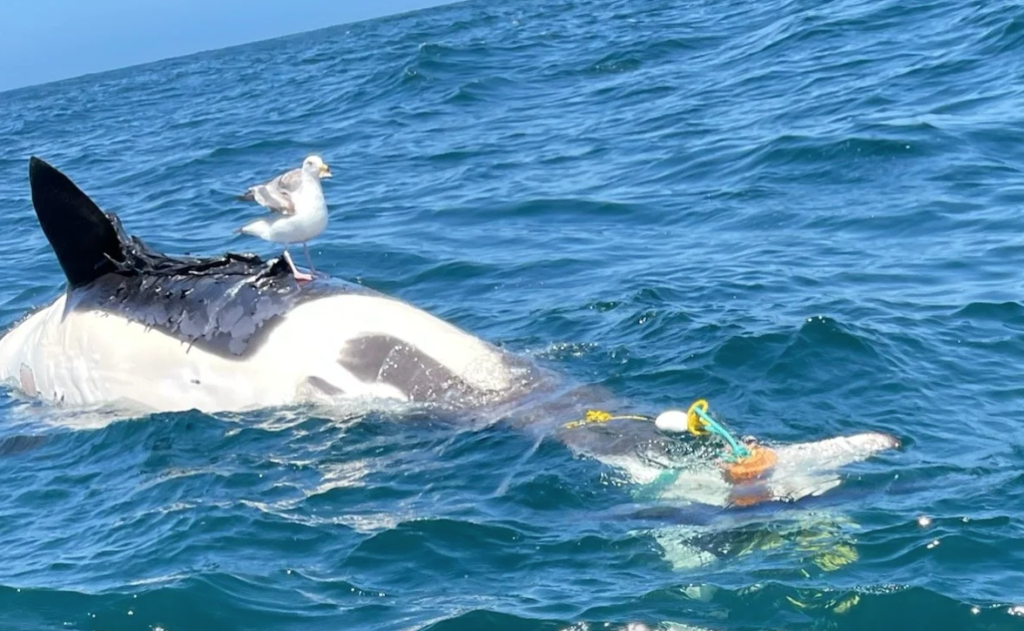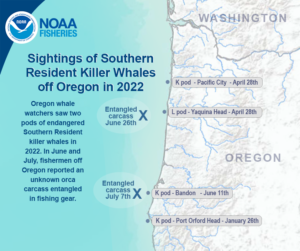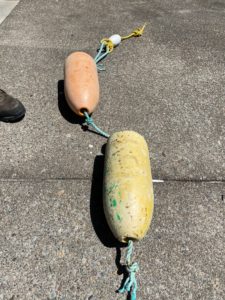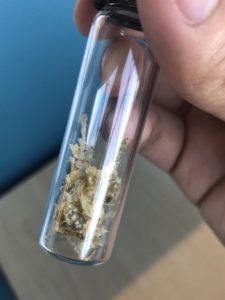
By MICHAEL MILSTEIN/NOAA Fisheries
The black-and-white pattern of a killer whale stood out to an Oregon fisherman 30 miles southwest of Newport. He spotted it at 1:47 p.m. June 26. The whale was belly up — and dead.
A lone gull stood atop the carcass, which had a turquoise and yellow rope wound tightly around its body above its tail flukes.
Over the next few weeks, the dead orca became the focus of one of the most unusual searches ever undertaken in waters off Oregon. Biologists wanted to know more about the whale, why it died, and, most of all where it came from.

Could the orca have been a critically endangered Southern Resident killer whale that went missing only a few weeks after its pod was sighted off Oregon? If so, it would be the first of the 73 remaining endangered killer whales known to die from entanglement in what was most likely recreational crab gear.
But during the same period last summer, transient killer whales were sighted off Oregon more frequently than ever before, said Jim Rice, Stranding Program manager with Oregon State University’s Marine Mammal Institute in Newport.
A flourishing population of harbor seals likely attracts the transient whales, which prey on seals and could be just as vulnerable to entanglement. In contrast, the endangered Southern resident killer whales feed mainly on salmon and other fish.
The population of transient killer whales along the Oregon coast is estimated at 500 and researchers are building a photo catalog to identify and track them.
Rice was the first stranding responder to get word of the dead, entangled orca. There was a second reported sighting of the carcass, still floating, a couple of weeks later 15-20 miles off Bandon.
At first the reports of the orca carcass generated many more questions than answers. Then, months later, the persistent work of a young scientist finally answered the question – endangered resident or plentiful transient?
DNA offers new potential
Last summer’s search for the Oregon orca is a story of fleeting sightings, delayed reports, and scattered photographs. It is also a story of one determined scientist using powerful genetic tools to unravel the ultimate mystery of the whale’s identity.
What the scientist needed was a piece of its DNA.

“We have a whole new suite of tools at our fingertips to help generate genetic information to identify species and even populations,” said Kim Parsons, who leads the Molecular Genetics Team at NOAA Fisheries’ Northwest Fisheries Science Center in Seattle. Last fall she helped identify the origin of a beluga whale that had roamed thousands of miles beyond its usual range into Puget Sound. She used a tiny sample of its DNA isolated from a sample of water collected near the animal.
The sample was called eDNA or environmental DNA because a team gathered it from the environment rather than the animal itself. It sample showed that the beluga was likely from the Arctic Ocean north of Alaska.
A water sample collected near the Oregon orca carcass might have revealed whether it was one of the endangered Southern Residents.
The Southern Resident population includes three pods — J, K, and L — each with its own geographic range. Only two pods — L and K — commonly venture south from Washington to Oregon and the rest of the West Coast. Whale watchers in Oregon sighted L-pod in April and K-pod in January and April, including K-pod’s first new calf in more than a decade. K-pod is the smallest pod with the fewest recent births.
Scientists determined the entangled Oregon killer whale was approximately 18.5 feet long — consistent with the last live measurement of a young Southern Resident killer whale that had gone missing from K-pod after its visit to Oregon.
While the entangled whale in the photographs was unequivocally a killer whale, researchers could not tell which population the young animal had come from.
A sample of eDNA from nearby water might have determined whether it was a resident or transient killer whale. But months later, only a tissue sample could now connect it to an individual whale based on more complete genetic details known for nearly all the endangered Southern Residents.
First sighting reported online
The first report of the Oregon orca came a day after the sighting on a fishing bulletin board. A fisherman posted a few photos of the carcass with the crab gear around its tail and the gull on top. He wrote, “It’s a sight I wish I could un-see.”
Rice heard about the post from a colleague. The distance offshore, uncertain location, late report, and rough seas made it hard for the stranding network to undertake a search.
“We were left with little to go on at that point,” Rice said.

The Stranding Network sought help from the U.S. Coast Guard, which had helicopters and airplanes out to enforce halibut season regulations. NOAA teams used computer models to estimate where the carcass might drift. A Coast Guard plane from Sacramento surveyed the area three days after the initial sighting. The Coast Guard cutter Blue Shark followed the estimated track of the carcass in reverse. The next day, an Oregon State Police patrol vessel joined the search.
The trail had all but gone cold when another fisherman came across the orca’s remains July 7 off Bandon. The fisherman took photos of the whale, which appeared to have been heavily scavenged by sharks, and cut some of the crab gear off the carcass.
The fisherman left the crab gear at the port office in Bandon. By then it was too late to launch another search. Oregon State University graduate student Charles Nye, who was assisting Rice in the Stranding Program lab, collected the gear.
Biologists inspect rope

About five days later biologists from the Oregon Department of Fish and Wildlife examined the gear at Rice’s lab in Newport. They found that it was likely recreational crab gear, but did not have the right marking or colors to have come from either Oregon or Washington waters.
As the last one to take charge of the gear, Nye felt some responsibility to see what he could learn from it. “I figured I was kind of the end of the line,” he said.
He cross-referenced photos the two fishermen had taken of the carcass, trying to tell which length of rope had been in contact with the whale’s carcass. He searched the rope, looking for any trace of skin, or “gunk that looked like it could be organic matter.” He wanted something that might provide enough DNA to tell if it was a resident or transient killer whale.
“To be honest I looked for the smelliest stuff, whatever might have genetic material in it,” he said.
He soaked a sample in solution that helps loosen bits of genetic material. Then he used next-generation sequencing to search for DNA. He found DNA from a barnacle, and a tiny organism called a rotifer. And a killer whale.
The initial scrap of DNA that Nye extracted was not enough to distinguish resident versus transient killer whales. He kept looking, thinking that if he found one piece of DNA, there could well be more. He continued to test promising bits of gunk for a segment of killer whale DNA large enough to reveal more about the whale.
“The challenge is that the ocean is so full of life that there’s not just killer whale DNA, there’s barnacle DNA, and crab DNA, and all sorts of DNA,” Nye said.
The best information would have come if someone had reported the carcass in time to collect full samples and complete an examination. Without that, DNA offered the best chance of identifying the animal.
DNA solves mystery

In late November, Nye found a bigger piece of killer whale genetic code. It came from a hunk of gunk he believes was decayed tissue from the carcass. He compared the sequence to published examples of DNA for resident and transient killer whales.
That produced a match – it was transient killer whale DNA, not an endangered Southern Resident.
Nye is confident his result answers the questions that followed the carcass down the Oregon Coast last summer. In the end it was a fortunate find of DNA from the tissue of the carcass, not eDNA, that answered the question.
“One of the takeaways is just how important the Stranding Network is in understanding risks to marine mammals,” said Lynne Barre, recovery coordinator for Southern Resident killer whales at NOAA Fisheries. “We want to learn from these cases, and there are top scientists working with dedicated volunteers to respond, and then collect enough information that we understand what happened.”
- Michael Milstein covered environment and science for almost a decade at The Oregonian newspaper before joining NOAA Fisheries as public affairs officer for the West Coast Region, Northwest Fisheries Science Center, and Southwest Fisheries Science Center. He can be reached at Michael.Milstein@NOAA.gov
-
Beachgoers or others who come across a whale carcass should report it as soon as possible to the West Coast Marine Mammal Stranding Network at (866)-767-6114 so trained teams can respond and collect data.





















Too bad you couldn’t identify the crabber who lost the trap, and send him a bill.